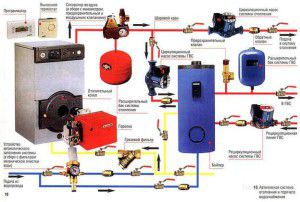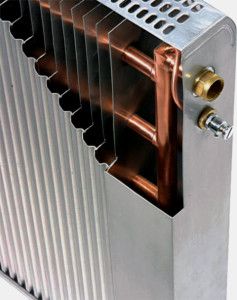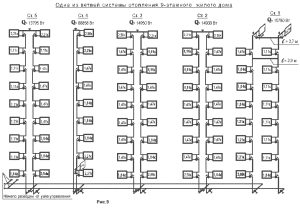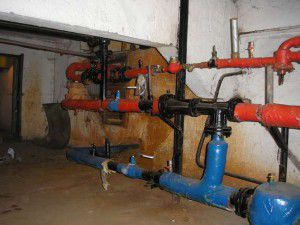A modern heating system is a complex complex whose work is aimed at maintaining a comfortable temperature level in the house. Depending on the method of obtaining thermal energy and its transportation, two main types of heating are distinguished - autonomous and centralized. Does a simple user need to know how heating systems are arranged: boilers, radiators, houses? In some cases, this information will help to carry out independent repairs or upgrades.
Principles of heating
Before you consider how a heating boiler or battery design is arranged, you need to understand the fundamental principles of constructing any circuit. It should consist of components that ensure the smooth operation of the entire system.
Regardless of how the heating system of a multi-storey building or a private cottage is arranged, heating, transportation and transfer of thermal energy to the premises should be ensured. For this, the following constituent elements are needed:
- Coolant heating. In autonomous systems, this function is performed by a boiler or any other heating device (electric convector, IR film, etc.). For central heating, I equip thermal distribution points that supply heated water to several multi-storey buildings;
- Highways - pipelines. According to them, the coolant is transferred from the source of its heating directly to the consumer. How is the heating system of a multi-storey building arranged and what is its difference from autonomous? For the first ordinary tenant of the house, in fact, can not affect the degree of heating of water in the pipes. In stand-alone, this is done by adjusting the power of the heating boiler;
- Batteries and radiators. They are designed to transfer thermal energy from hot water to indoor air. Depending on how the heating battery is arranged, it can have various parameters of energy intensity and heat transfer.
How to arrange a heating system and what should be chosen first of all for its configuration? Of great interest is the arrangement of autonomous circuits in private houses, since in this case the owner himself chooses a source of thermal energy, plans piping, and the operating parameters of the system.
In order to arrange a heating system yourself - you must first calculate the heat loss in the building. Based on this, you can choose a boiler of a certain power.
Autonomous heating system
What parameters should be followed when choosing a boiler, and how is the heating radiator arranged? This is only a small part of the issues that the owner of a private house has to solve when planning a heating system. First, a heating scheme is developed, its main parameters are determined - the temperature mode of operation, the number and location of radiators, control devices.
The next step is to find out how the boiler is designed for heating, and choose the optimal model. This is very important, since it will directly affect the efficiency and characteristics of the entire heating circuit of the house.
Heating boiler device
The principle of operation of any boiler is to receive thermal energy from an energy carrier (coal, firewood, gas, diesel fuel) and transfer it to a heat carrier. The device of the heating boiler directly depends on the type of fuel used. Consider this using the most common gas models as examples.
The main component in this case is the burner.In it, the energy from the hot gas is transferred to the water through a heat exchanger. In solid fuel models, this function is performed by the combustion chamber. In addition, the following components are often present in boilers:
- The system of water supply to the heat exchanger;
- Chimney pipe for carbon monoxide exhaust;
- Controls - control of flame intensity, СО2 content, draft, water temperature, etc .;
- Circulation pump - designed to increase the speed of movement of the coolant. Most solid fuel and some gas boilers are not included in the package;
- Expansion tank and security system.
When choosing gas models, special attention should be paid to the presence of a second circuit intended for domestic hot water.
It is not recommended to purchase a boiler whose power is higher than required. This will lead to an increase in energy consumption and, as a result, an increase in financial costs for maintenance.
The device of heating radiators
The heating radiator device has not changed for many years. Despite the use of new manufacturing materials, improving the appearance of the battery - when it is created, it is always guided by a proven scheme.
What are the principles of a standard heating battery? It should consist of two components - pipelines through which the coolant flows and a heat exchange surface. When designing, they try to increase thermal efficiency and at the same time reduce the useful volume of the transport line. To do this, materials with an increased heat transfer coefficient are used in the heating radiator device - aluminum, copper, etc. It is important for the user to pay attention to the following parameters of the standard battery device for heating:
- Rated power. Manufacturers indicate the value of this characteristic at a certain temperature regime of the system. For example - 70/55 or 90/70;
- Section or panel model. For the former, there is the possibility of increasing the usable area by adding sections;
- Connection method. It is important to know this when analyzing the design of a heating system in an apartment building. If there is an upper wiring of pipes, models with side connection should be purchased.
In addition to installing radiators, their correct binding is necessarily provided. Its components are shutoff valves, a Mayevsky crane. For greater efficiency, the installation of a thermostatic valve is recommended.
One of the main factors in the normal operation of the radiator is its proper installation and connection. If the norms are not observed, its efficiency may decrease by 10-15%.
Central heating system
The heating system of a multi-storey building is much more complicated. It is a complex complex consisting of a distribution (elevator) unit, risers and heating appliances.
The heat supply network is characterized by high water pressure in the pipes and high temperature. How is heating arranged in a five-story building, and how do these parameters stabilize to acceptable values?
Elevator assembly
It is designed to connect the house to the heating main and is an indispensable element in the heating device in a five-story building. It provides mechanisms for supplying water through the internal networks of the building, there is a zone to reduce its temperature to the required value, and pressure normalization also takes place here.
A properly arranged heating system in an apartment building should contain the following components of the elevator unit:
- Mud collectors - traps of polluting elements in the coolant;
- Manometers and thermometers;
- Thermal energy meter.
After stabilization of the coolant to the required parameters, it enters the internal wiring of pipes for supply to the apartment of the house.
All work on the adjustment and control of the elevator unit should be carried out by representatives of the management company.
Internal heating pipes
Distribution of hot water occurs using risers. There can be several - from 2 to 8, depending on the heating scheme. In the houses of the Khrushchev project, you can find 2-5 risers passing through one apartment. Such arrangement significantly complicates the organization of individual heat metering.
Why should the average consumer know how home heating systems are arranged: boilers, radiators, etc.? This can come in handy when planning, repairing, and maintaining the system yourself. But before you perform this or that type of work, you need to carefully study the characteristics of heating and individual components.
You can learn more about the principle of operation of heating an apartment building from the video material:








